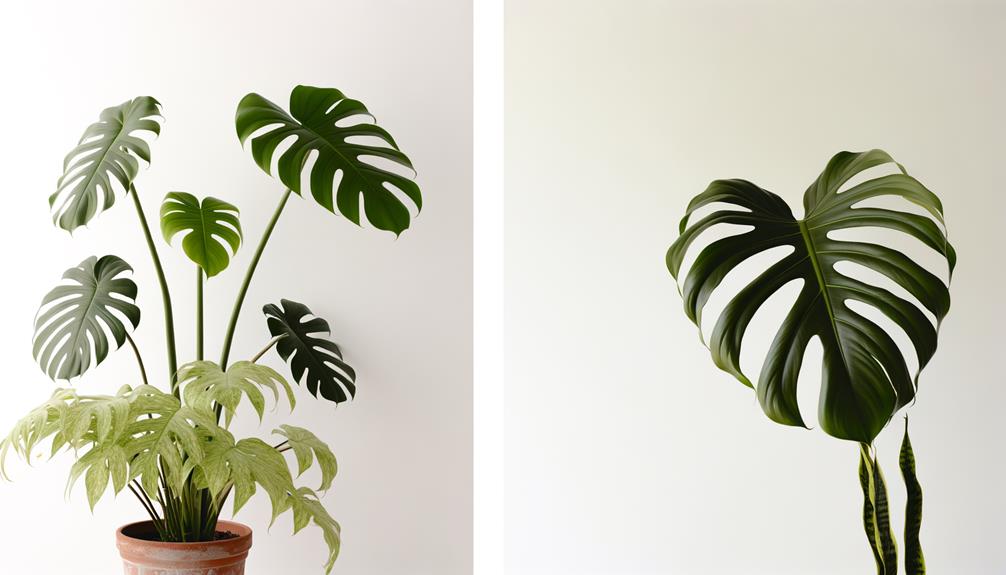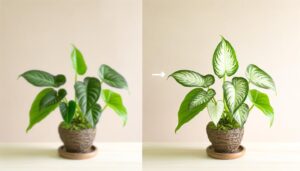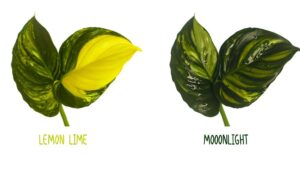Monstera Deliciosa Vs Philodendron Bipinnatifidum: Details!
Monstera deliciosa, native to Central America, prefers regions with 1,800-2,500 mm of annual rainfall and temperatures between 20°C-30°C. It features large, perforated, heart-shaped leaves up to 90 cm and climbs to over 20 meters via aerial roots.
In contrast, Philodendron bipinnatifidum, indigenous to South America, thrives with 1,250-2,000 mm of annual rainfall and showcases deeply lobed leaves reaching 150 cm, forming a tree-like structure up to 3 meters. Both plants require well-draining soil (pH 5.5-7.5) and balanced fertilization.
Further examination will uncover their distinct light, humidity preferences, and propagation methods.
Comparison of Monstera Deliciosa and Philodendron Bipinnatifidum
| Feature | Monstera Deliciosa | Philodendron Bipinnatifidum |
|---|---|---|
| Common Names | Swiss Cheese Plant, Split-Leaf Philodendron | Tree Philodendron, Lacy Tree Philodendron |
| Scientific Name | Monstera deliciosa | Philodendron bipinnatifidum |
| Family | Araceae | Araceae |
| Origin | Tropical rainforests of Central and South America | Tropical regions of South America |
| Leaf Shape | Large, heart-shaped leaves with deep splits and holes | Large, deeply lobed leaves |
| Leaf Size | Can grow up to 3 feet long | Can grow up to 4 feet long |
| Growth Habit | Climbing vine | Upright, self-supporting |
| Mature Height | Up to 10-15 feet indoors, larger outdoors | Up to 15 feet indoors, larger outdoors |
| Light Requirements | Bright, indirect light | Bright, indirect light |
| Watering Needs | Moderate; allow top inch of soil to dry out | Moderate; keep soil consistently moist |
| Humidity Requirements | High | High |
| Temperature Tolerance | Prefers 65-85°F (18-29°C) | Prefers 65-80°F (18-27°C) |
| Soil Preference | Well-draining, rich soil | Well-draining, rich soil |
| Fertilization | Monthly during growing season | Monthly during growing season |
| Toxicity | Toxic to pets and humans | Toxic to pets and humans |

Origin and Habitat
Monstera deliciosa, native to the tropical rainforests of Central America, thrives in the humid, warm environments found from southern Mexico to Panama.
This species flourishes in regions with annual precipitation ranging from 1,800 to 2,500 millimeters and average temperatures between 20°C to 30°C. The plant is typically found at elevations up to 1,500 meters, where it benefits from well-drained, nutrient-rich soils.
Philodendron bipinnatifidum, indigenous to South America, particularly Brazil, Argentina, Paraguay, and Bolivia, inhabits subtropical and tropical forests. This species adapts well to areas with annual rainfall of 1,250 to 2,000 millimeters and temperatures from 15°C to 28°C.
It is commonly located at elevations below 1,000 meters and favors loamy, well-aerated soils with high organic content.
Leaf Structure
Characterized by their distinctive fenestrations, the leaves of Monstera deliciosa exhibit large, glossy, heart-shaped blades with deep lobes and perforations that can reach up to 90 centimeters in length and 75 centimeters in width.
These fenestrations, or natural holes, are believed to help withstand high winds and allow light to pass through to lower leaves.
In contrast, Philodendron bipinnatifidum features deeply lobed, pinnately compound leaves that can extend up to 150 centimeters in length. The intricate, feather-like structure of its leaves, with multiple narrow lobes, aids in maximizing photosynthetic efficiency.
While both species exhibit unique adaptations, the Monstera’s perforations and the Philodendron’s segmented structure each serve specific ecological functions, offering distinct aesthetic and functional characteristics in their respective environments.
Growth Patterns
Beyond their distinctive leaf structures, the growth patterns of Monstera deliciosa and Philodendron bipinnatifidum are equally fascinating, with the former exhibiting a climbing habit facilitated by aerial roots and the latter developing a more self-supporting, tree-like form as it matures.
Monstera deliciosa, a hemiepiphyte, utilizes robust aerial roots to anchor itself to vertical surfaces, enabling it to reach heights exceeding 20 meters in ideal conditions. Its growth is characterized by extensive vining and periodic leaf fenestration.
Conversely, Philodendron bipinnatifidum, a terrestrial species, forms a thick, woody trunk that can support its broad canopy without external support. This species typically reaches a mature height of 1.5 to 3 meters, with a spread of up to 2 meters.
Light Requirements
Monstera deliciosa and Philodendron bipinnatifidum exhibit distinct preferences regarding light requirements. Monstera deliciosa thrives in bright, indirect sunlight with ideal exposure ranging from 10,000 to 20,000 lux, while Philodendron bipinnatifidum can tolerate slightly lower light levels, ideally between 5,000 and 10,000 lux.
Inadequate lighting conditions can lead to etiolation, chlorosis, and reduced photosynthetic efficiency in both species.
Ideal Lighting Conditions
Both Monstera deliciosa and Philodendron bipinnatifidum thrive in bright, indirect light, with ideal exposure ranging between 10,000 to 20,000 lux to promote healthy growth and foliage development. These conditions mimic their native tropical environments where light is filtered through the canopy.
It is recommended to position these plants near east or west-facing windows, where they can receive ample indirect sunlight without the risk of leaf scorching. Supplementary lighting, such as LED grow lights with a color temperature of 5,000 to 6,500 Kelvin, can be used to maintain prime light levels, especially in low-light conditions.
Ensuring consistent light exposure within this range will foster vigorous growth, maintain leaf variegation, and prevent etiolation.
Common Light Issues
Frequently, inadequate light levels can lead to etiolation in both Monstera deliciosa and Philodendron bipinnatifidum, characterized by elongated, pale stems and sparse foliage. This morphological adaptation results from insufficient photon flux density, typically below 100 μmol/m²/s.
In Monstera deliciosa, reduced light can also inhibit fenestration development, impairing its iconic leaf morphology. Conversely, Philodendron bipinnatifidum may exhibit an increased internodal length and diminished leaf size under suboptimal lighting.
Both species thrive under bright, indirect light, ideally within the range of 150-250 μmol/m²/s for balanced growth. It is important to avoid direct sunlight, which can lead to chlorophyll degradation and subsequent leaf scorching.
Regularly rotating the plants guarantees even light distribution, mitigating asymmetric growth patterns.
Watering Needs
Both Monstera deliciosa and Philodendron bipinnatifidum have specific watering needs that promote ideal growth and health.
Monstera deliciosa typically prefers soil that remains consistently moist but not waterlogged, requiring watering approximately once a week.
Philodendron bipinnatifidum thrives in slightly drier conditions, needing watering every 7-10 days.
Signs of overwatering in both species include yellowing leaves and root rot, which requires immediate corrective actions to prevent plant decline.
Frequency of Watering
Determining the best watering frequency for Monstera deliciosa and Philodendron bipinnatifidum involves understanding their distinct hydration requirements influenced by their native tropical habitats. Monstera deliciosa typically thrives with moderate watering, allowing the top 2-3 inches of soil to dry out between waterings.
In contrast, Philodendron bipinnatifidum prefers a consistently moist environment but not waterlogged conditions.
To optimize watering frequency, consider the following guidelines:
- Monstera deliciosa: Water approximately every 1-2 weeks, adjusting based on ambient temperature and humidity.
- Philodendron bipinnatifidum: Maintain a bi-weekly watering schedule, increasing frequency during warmer months.
- Humidity levels: Both plants benefit from elevated humidity (50-60%).
- Seasonal adjustments: Reduce watering frequency during winter months as plant growth slows.
Signs of Overwatering
Excessive watering of Monstera deliciosa and Philodendron bipinnatifidum can manifest through specific physiological and morphological symptoms, indicating waterlogged conditions detrimental to plant health. Recognizing these signs can prevent irreversible damage to the plants.
- Yellowing Leaves: Chlorosis occurs due to reduced oxygen availability, impairing chlorophyll synthesis.
- Root Rot: Waterlogged soil promotes pathogen proliferation, leading to necrosis of the root system.
- Wilting: Despite ample moisture, impaired root function hinders water uptake, resulting in turgor loss.
- Edema: Cell walls rupture due to excessive water absorption, causing blister-like formations on leaves.
Identifying these symptoms early allows for corrective measures, such as adjusting watering frequency and improving soil drainage, to restore ideal plant health.
Soil Preferences
Both Monstera deliciosa and Philodendron bipinnatifidum thrive in well-draining, nutrient-rich soil with a pH range of 5.5 to 7.5. Best soil composition includes a mix of peat moss, perlite, and pine bark, guaranteeing sufficient aeration and moisture retention.
Peat moss, comprising about 40% of the blend, boosts water retention, while perlite, at approximately 30%, maintains proper drainage. Pine bark, accounting for the remaining 30%, offers necessary nutrients and structure.
Moreover, integrating organic matter like compost or worm castings can further enhance the soil, supporting strong root development.
Ensuring adequate drainage is vital to prevent root rot, a common issue in poorly aerated soils. Regular monitoring of soil pH and nutrient levels is suggested for top-notch plant health.
Temperature Tolerance
Ideal temperature ranges for Monstera deliciosa and Philodendron bipinnatifidum are between 65°F and 85°F (18°C to 29°C), with both species exhibiting reduced growth rates and potential stress symptoms when exposed to temperatures outside this range.
Both plants thrive in stable, warm conditions and are sensitive to sudden temperature fluctuations.
Key considerations include:
- Optimal Growth: Consistent temperatures between 70°F and 80°F (21°C to 27°C) are ideal for robust growth.
- Stress Indicators: Temperatures below 50°F (10°C) can lead to leaf discoloration and wilting.
- Heat Tolerance: Sustained exposure above 90°F (32°C) may result in leaf burn and dehydration.
- Night Temperatures: Maintaining night temperatures above 60°F (16°C) guarantees minimal stress.
Understanding these parameters aids in promoting healthy plant development.
Humidity Levels
The ideal humidity range for Monstera deliciosa is 60-80%, while Philodendron bipinnatifidum thrives at 50-60%.
Exposure to humidity levels below these ranges can result in desiccation, leaf curl, and reduced photosynthetic efficiency.
Methods to increase humidity include utilizing humidifiers, misting the foliage, and placing plants on pebble trays with water.
Ideal Humidity Ranges
Understanding the best humidity levels for Monstera deliciosa and Philodendron bipinnatifidum is crucial, as these tropical plants thrive in environments with relative humidity levels ranging from 60% to 80%. Maintaining such conditions ensures peak physiological functions, including transpiration and nutrient uptake.
To achieve these humidity levels, consider the following strategies:
- Humidifiers: Use a humidifier to consistently maintain indoor humidity within the desired range.
- Misting: Regularly mist the foliage to provide a temporary boost in humidity.
- Pebble Trays: Place the plant pot on a tray filled with water and pebbles to increase local humidity.
- Grouping Plants: Cluster tropical plants together to create a microenvironment with higher humidity.
These methods can greatly enhance the growth and health of both Monstera deliciosa and Philodendron bipinnatifidum.
Effects of Low Humidity
Low moisture levels, typically below 40%, can lead to substandard physiological processes in Monstera deliciosa and Philodendron bipinnatifidum, manifesting in symptoms such as leaf browning, stunted growth, and increased susceptibility to pests.
These plants, native to tropical regions, thrive in environments where relative humidity ranges between 60% to 80%. When exposed to arid conditions, stomatal closure occurs to reduce transpiration, thus limiting photosynthesis and nutrient uptake.
This physiological stress results in necrotic leaf margins and tips, reduced foliar expansion, and a weakened defense mechanism against common pests like spider mites. Persistent low moisture can disrupt cellular turgor pressure, leading to impaired structural integrity and compromised overall plant health.
Maintaining adequate humidity is crucial for their peak growth and resilience.
Increasing Humidity Tips
Elevating humidity levels to the ideal range of 60% to 80% can be achieved through the implementation of specific horticultural techniques and equipment.
To ensure the best growth environment for Monstera deliciosa and Philodendron bipinnatifidum, consider the following methods:
- Humidifiers: Utilize ultrasonic or evaporative humidifiers to consistently maintain ambient humidity levels within the desired range.
- Pebble Trays: Place plants on trays filled with water and pebbles; as the water evaporates, it increases the surrounding humidity.
- Misting: Regularly mist the foliage with demineralized water to provide an immediate, albeit temporary, boost in humidity.
- Grouping Plants: Position multiple plants together to create a microenvironment that retains higher humidity due to collective transpiration.
Implementing these strategies can greatly enhance plant health and vigor.
Fertilization
Administering appropriate fertilization is crucial for optimizing the growth and health of both Monstera deliciosa and Philodendron bipinnatifidum. It guarantees they receive essential nutrients in precise proportions.
For Monstera deliciosa, a balanced fertilizer containing nitrogen (N), phosphorus (P), and potassium (K) in a 20-20-20 ratio, applied every four to six weeks during the growing season, is recommended.
Philodendron bipinnatifidum benefits from a similarly balanced fertilizer but can tolerate a slightly lower phosphorus concentration, such as a 10-10-5 formulation, applied monthly.
Both species require micronutrients, including iron, magnesium, and calcium, to prevent deficiencies. Avoid excessive fertilization, which can lead to nutrient burn, and maintain proper watering practices to enable nutrient absorption and root health.
Pruning Techniques
Effective trimming methods are crucial for managing the size, shape, and overall health of both Monstera deliciosa and Philodendron bipinnatifidum, requiring careful attention to the timing and method of each cut.
Regular trimming, ideally carried out during the plant’s active growth phase in spring or early summer, ensures optimal outcomes. Using sterilized, sharp pruning shears minimizes the risk of infection and tissue damage.
Key practices include:
- Eliminate Dead or Diseased Tissue: Remove necrotic or infected leaves and stems to prevent pathogen spread.
- Manage Size and Shape: Trim excessively long branches to maintain desired form and spatial requirements.
- Enhance Airflow: Thin out dense foliage to improve ventilation and reduce humidity-related issues.
- Stimulate New Growth: Trim at nodes to encourage vigorous, new shoots.
These techniques promote plant health and visual appeal.
Common Pests
While pruning methods contribute greatly to the health and aesthetics of Monstera deliciosa and Philodendron bipinnatifidum, managing common pests such as spider mites, mealybugs, and scale insects is equally essential in maintaining the vigor of these plants.
Spider mites (Tetranychus urticae) are small arachnids, usually less than 0.5 mm, that cause stippling and leaf discoloration. Mealybugs (Pseudococcidae family), at about 3 mm, excrete honeydew, leading to sooty mold growth. Scale insects (Coccoidea superfamily) form protective coverings, appearing as tiny bumps, and feed by piercing plant tissues.
Effective pest control involves regular inspection, maintaining humidity around 60%, and using insecticidal soaps or neem oil applications at 1-2% concentrations, ensuring thorough coverage for optimal pest eradication.
Propagation Methods
Propagation of Monstera deliciosa and Philodendron bipinnatifidum can be achieved through stem cuttings, air layering, or division. Each method requires specific techniques and conditions to guarantee successful plant reproduction.
- Stem Cuttings: Select a healthy stem segment with at least one node. Place it in water or a well-aerated growing medium, maintaining a humidity level of approximately 70%.
- Air Layering: Make an incision on the stem, wrap it in moist sphagnum moss, and cover with plastic wrap. Ensure consistent moisture and monitor root development.
- Division: Carefully separate the root ball into smaller sections, each containing a portion of the root system. Replant immediately in suitable soil.
- Water Propagation: Submerge the lower part of the cutting in water, ensuring the node is underwater. Change water weekly.
Conclusion
To sum up, Monstera deliciosa and Philodendron bipinnatifidum display unique traits that set them apart in the world of botany. Particularly, Monstera deliciosa can develop leaves up to 90 centimeters in size, creating a vibrant, tropical look.
Understanding their specific requirements regarding light, water, and nutrients is essential for ideal development. Additionally, identifying common pests and successful propagation techniques guarantees plant well-being and lifespan, underscoring the significance of personalized care for each species in gardening practices.






